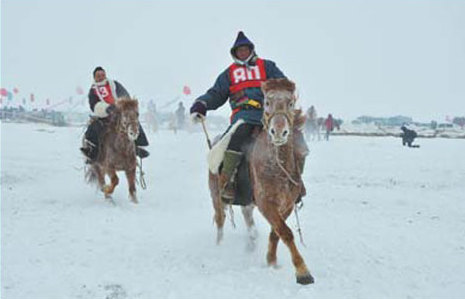Discovering ancient land and culture at Nadam Fair
Locals say good times to visit the Inner Mongolia autonomous region come both in summer and winter when the twice-yearly Nadam Fair is held.
The latest Winter Nadam Fair was held in December in Hulunbuir when the city was covered by mist and decorated with snow sculptures.
Meaning entertainment or game in Mongolian, Nadam is a traditional celebration that has its roots in the early 13th century when it was started by Genghis Khan. To Mongolians, it is ancient and holy.
Today it is also a good chance to better understand the region's distinctive character as well as its diverse ethnic groups such as the Ewenkis, Mongolians and Daurs, said local officials.
Riding on horses with furs and medicinal herbs on their back to be traded at the fair, nomadic people across the region gather as the festival opens and erect their iconic white Mongolian yurts on the grassland.
They dress in gorgeous local gowns with five-colored ribbons on their shoulders.
According to historical records, Nadam before served as a memorial ritual honoring mountain gods and to celebrate a community endeavor.
In the Qing Dynasty (1644-1912), the festival became an official event held at intervals ranging from every six months to yearly or every three years.
The annual gathering has now grown in form and scale. It is also open to any ethnic or religious group. Even foreigners can participate.
More activities such as sacrificial rites, car racing and trade are included in the event, but the three traditional games of wrestling, horse racing and archery are still the most popular in the weeklong celebration.
Unlike other wrestling matches, the local contest has no weight divisions and the one who falls first loses. It has few rules except for prohibitions on dragging legs, punching in the face, pulling hair and biting.
Archery is an ancient sport in the region that originated in the 11th century. Contestants shoot arrows made from willow branches and vulture feathers to a round targets with gray, yellow or red rings.
The festival also has various kinds of horse races.
A large Nadam will have 300 horses chosen to compete and lasts up to 10 days, while the smallest will be three to five days with about 50 horses in the competition.
It was placed on the list of national intangible cultural heritage in 2006.
haonan@chinadaily.com.cn
The latest Winter Nadam Fair was held in December in Hulunbuir when the city was covered by mist and decorated with snow sculptures.
Meaning entertainment or game in Mongolian, Nadam is a traditional celebration that has its roots in the early 13th century when it was started by Genghis Khan. To Mongolians, it is ancient and holy.
Today it is also a good chance to better understand the region's distinctive character as well as its diverse ethnic groups such as the Ewenkis, Mongolians and Daurs, said local officials.
Riding on horses with furs and medicinal herbs on their back to be traded at the fair, nomadic people across the region gather as the festival opens and erect their iconic white Mongolian yurts on the grassland.
They dress in gorgeous local gowns with five-colored ribbons on their shoulders.
According to historical records, Nadam before served as a memorial ritual honoring mountain gods and to celebrate a community endeavor.
In the Qing Dynasty (1644-1912), the festival became an official event held at intervals ranging from every six months to yearly or every three years.
The annual gathering has now grown in form and scale. It is also open to any ethnic or religious group. Even foreigners can participate.
More activities such as sacrificial rites, car racing and trade are included in the event, but the three traditional games of wrestling, horse racing and archery are still the most popular in the weeklong celebration.
Unlike other wrestling matches, the local contest has no weight divisions and the one who falls first loses. It has few rules except for prohibitions on dragging legs, punching in the face, pulling hair and biting.
Archery is an ancient sport in the region that originated in the 11th century. Contestants shoot arrows made from willow branches and vulture feathers to a round targets with gray, yellow or red rings.
The festival also has various kinds of horse races.
A large Nadam will have 300 horses chosen to compete and lasts up to 10 days, while the smallest will be three to five days with about 50 horses in the competition.
It was placed on the list of national intangible cultural heritage in 2006.
haonan@chinadaily.com.cn

Comments
Post a Comment